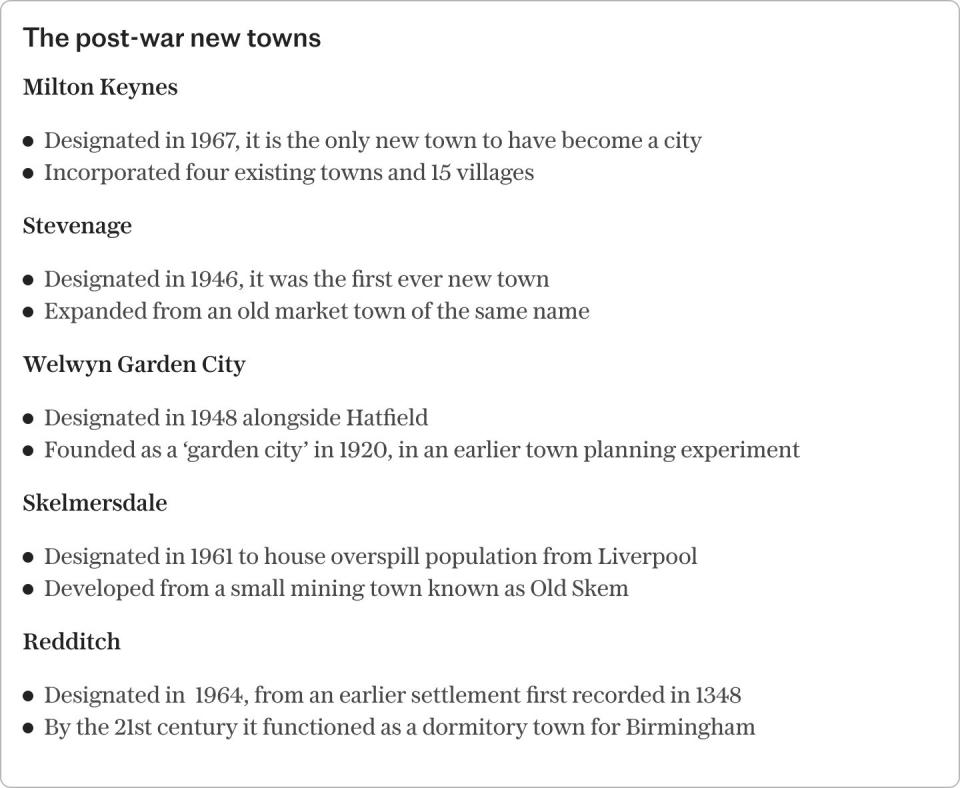Why Labour’s pledge to build more houses than the Tories doesn’t add up

Labour has promised to out-do the Conservative government’s track record on house building, but experts aren’t convinced that their reforms will go far enough.
Keir Starmer has pledged to build 1.5 million new homes – an average of 300,000 per year – over the course of the next parliament, a target the Tories have so far failed to hit.
Last year, 232,800 homes were delivered. Now the number of new homes gaining planning consent has fallen below the number of new homes being completed, a feat not achieved since the financial crisis according to estate agency Savills.
Labour has committed to planning reforms which would make it harder for councils to scrimp on their house building targets, after Michael Gove moved the goalposts in their favour last year.
But these reforms alone will simply revert England to the era of deregulation seen under David Cameron – when the fewest houses of any prime minister were built since 1923.
Labour’s reforms also ignore Britain’s dwindling skilled workforce. A 2018 government-commissioned report identified “an insufficient supply of bricklayers”, which it said was going to be “a binding constraint in the immediate future” unless homes were constructed differently, or more skilled bricklayers were hired from abroad.
Neither has happened since that report was published.
As a result, the Construction Industry Training Board now says the UK needs over 251,000 extra workers over the next four years to meet its construction output.
Richard Knox-Johnston, of the London Green Belt Council, said a lack of construction workers means “we’ll never reach the figures they’re [Labour] talking about. Brexit lost us Eastern European workers, and a lot of workers who are left are approaching retirement”.
Provided Labour does find the manpower, shadow deputy prime minister Angela Rayner wants to deliver a new generation of “post-war” new towns.
The Tories have tried the new towns route too. Under Cameron, the Healthy New Towns programme was introduced in 2015 with NHS England. In Cambridge, Northstowe – a new town created under the scheme – is still being built, some nine years later.
And while Starmer’s aspirations to build “Georgian townhouse-style” homes, rather than box-like homes, are admirable, consultants say this will be tough to do in a sector dominated by a small monopoly of developers which dictate 20pc profit margins.
‘A time machine back to 2018’
Developers are excited for the dawn of a Labour government. One industry insider said it will bring with it a “planning genius” in the form of Matthew Pennycook – Labour’s shadow housing minister.
Standing for re-election as Labour MP for Greenwich and Woolwich, Mr Pennycook has led the charge on Labour’s intention to immediately re-introduce mandatory house building targets for local authorities.
When the National Planning Policy Framework (NPPF) was drafted back in 2012 under Cameron, it required every council to submit data – such as population, birth rates and the number of new businesses – to the Government. Out from that popped a house building target.
Last year, Gove dropped top-down targets and let local authorities assess their own planning needs instead. His argument was that some councils had no plans in place, because they couldn’t get anywhere near their state-dictated targets.
Better to have a plan even if it means less homes, Gove thought. And so lots of councils withdrew their local plans and reallocated them with far fewer properties.
Labour has said it will reinstate Cameron’s top-down targets, and has additionally promised to fund 300 new planning officers.
Ant Breach, of think tank Centre for Cities, said much of Labour’s planning reforms are “cautious” at best.
He added: “There is a gap between what Labour is saying it wants planning reform to achieve – which is now a load-bearing part of their economic strategy – and the actual proposed planning reforms, which are very cautious.
“Labour wants to take a time machine back to 2018, bringing back targets, reversing the changes to the NPPF, and even having the same target of 300,000 new homes a year over five years, and for that to then deliver much higher economic growth than under the Conservatives.
“Long-term reforms to planning are needed. Otherwise, the only way a future government is going to be able to sustain house building is by constantly putting huge amounts of pressure on councils who don’t want to build and use the planning system to stop construction.”
Mr Breach said some changes, such as allowing parts of green belt land to be classified as “grey belt” and therefore free for development, will help increase house building rates.
But bigger issues bottlenecking house building, such as net neutrality targets and the UK’s bureaucratic planning permission process which differs from much of Europe, have gone untouched by Labour in its pledges.
According to the Home Builders Federation, the Government’s Biodiversity Net Gain policy which went live earlier this year has “massively increased” planning workloads.
It requires house builders to improve biodiversity by 10pc post-development and sustain this for at least 30 years.
Developers do not expect Labour to water down any environmental requirements.
Steve Turner, of the Home Builders Federation, said: “Any new Government is unlikely to water down environmental requirements. If anything, they could make them more stringent, further heightening the need for more capacity in planning departments.”
Greenbelt land is not as available as Labour thinks
Anna Clarke, of property body The Housing Forum, predicts that Labour will encounter the same challenges Gove did once it starts trying to push through top-down housing targets in communities where lots of residents have opposed new development for years.
Ms Clarke said: “A greater focus on strategic regional and mayoral-level governance in deciding where housing should go would help.
“The large proportion of MPs that Labour will have, who are both new MPs and former local councillors, will inevitably mean their national ambition for house building may conflict with their MP focus on championing the issues of their local constituents.”
At least 32 Labour candidates – including shadow cabinet minister Lisa Nandy, shadow climate minister Ed Milliband and shadow home secretary Yvette Cooper – previously held seats in constituencies where half or more of land was classified as green belt, according to Telegraph analysis of data from The Countryside Charity (CPRE) last year.
Now, with an election just weeks away, many more candidates will be vying for seats previously held by Tory MPs set in much-loved green belt land.
Starmer has said he will take a “brown-field-first” approach to house building, before looking to develop on the green belt where councils could be given stronger compulsory purchase order powers – which allow local authorities to obtain land without an owner’s permission.
But one planning insider, on the condition of anonymity, has dubbed these plans “naive” and fears Labour doesn’t understand how land markets work.
They said: “Labour thinks councils will be able to issue compulsory purchase orders for former greenbelt land at existing use price [minus its potential value, otherwise known as ‘hope value’].
“The reality is that a lot of land on the greenbelt may already have had options sold on it, or changed hands for more than the existing use value because of the potential for it being zoned for housing in future.”
The Levelling Up and Regeneration Act, passed last year, already allows Homes England and councils to use compulsory purchase orders – with the additional option of applying to the Levelling Up secretary for permission to remove a hope value. It is understood Labour might remove the need for permission.
Compulsory purchase orders have propped up parts of HS2, the UK’s yet-to-be-finished high-speed rail network, and helped build thousands of new homes in Sheffield city centre.
Though “protracted”, when compulsory purchase orders work they can be “demonstrably effective” according to Elizabeth Bundred Woodward, of Campaign to Protect Rural England.
But she added: “We would urge Labour to reform the Land Compensation Act and remove hope value entirely to help smaller community groups that focus on building more affordable homes in keeping with their villages.”
Georgian townhouses ‘a misnomer’
Starmer has vowed to not only deliver the numbers on housing, but also the quality. He has pledged to bring with him a new generation of new towns and Georgian-style housing in urban areas.
He would incentivise developers to build nicer-looking homes and get them “planning passports” in return to speed up development projects.
Ms Woodward said the promise of Georgian townhouses was “a bit of a misnomer”. “What Labour is effectively saying is it wants more high quality housing, something local communities are far more inclined to support,” she added.
In the Tories’ Levelling Up and Regeneration Act, the Government promised to legislate a set of “national development management policies” requiring developers to build to a nationally set code.
These policies, expected to cover design, heritage and national parks, have not yet been published. At present, councils sporadically include requirements in their local plans – but many are struggling to adopt these plans, paving the way for developers to build what they like.
The small number of major developers which dominate house building is also driving the shape of new homes as we see them today, according to Murray Lloyd, of property consultancy Continuum.
He said the 10 biggest developers aim to make a 20pc profit. So, if someone was to buy a house on a new estate for half a million, a developer will want to make at least £100,000 to reflect the “risk” they take on to build it, Mr Lloyd explained.
“We massively under supply housing on an annual basis relative to need and market demand. So we should be asking – are these sorts of profit margins actually reflective of the risk developers take on when building these homes?
“This is the huge elephant in the room. Better quality homes could be sold for a lot less and everyone would still achieve the same outcome.”
New towns can take decades – ask the Tories
Rayner has pledged “Labour’s towns of the future” will include green spaces, good transport links and a 40pc proportion of new affordable homes.
But experts have already told The Telegraph that the success of Milton Keynes, a new town approved back in the 1960s under a Labour government, would be much harder to replicate today – not least because there is far less land available.

In 2009, Gordon Brown tried to introduce 10 “eco” towns. But they were later shot down by protests and a legal challenge.
Later, in 2014, the Tories announced the now-named “Ebbsfleet Garden City” – said to bring with it 15,000 homes by 2035.
But a decade later, just 3,516 new homes have been delivered and residents in Kent’s new garden city are still waiting on much-needed infrastructure, including a gym, a GP, a library and co-working spaces.
“We were promised so much when we first moved,” one resident told the Kent Online newspaper earlier this year. She has lived there for seven years and has two children.
In Cambridge, the Government is still building Northstowe – a new town that started nearly a decade ago.
Ms Woodward said: “It’s unclear how Labour’s new towns proposals will differ from those already in motion.
“It’s also unlikely to be the mechanism in which they are able to develop their quota of housing within the first parliamentary term, should they form a government, as permissions and construction for large, multi-phased sites can take decades.
“Even with a reformed planning system, it’s unlikely this will be accelerated sufficiently to produce the number of homes they are after.”


 Yahoo Finance
Yahoo Finance 